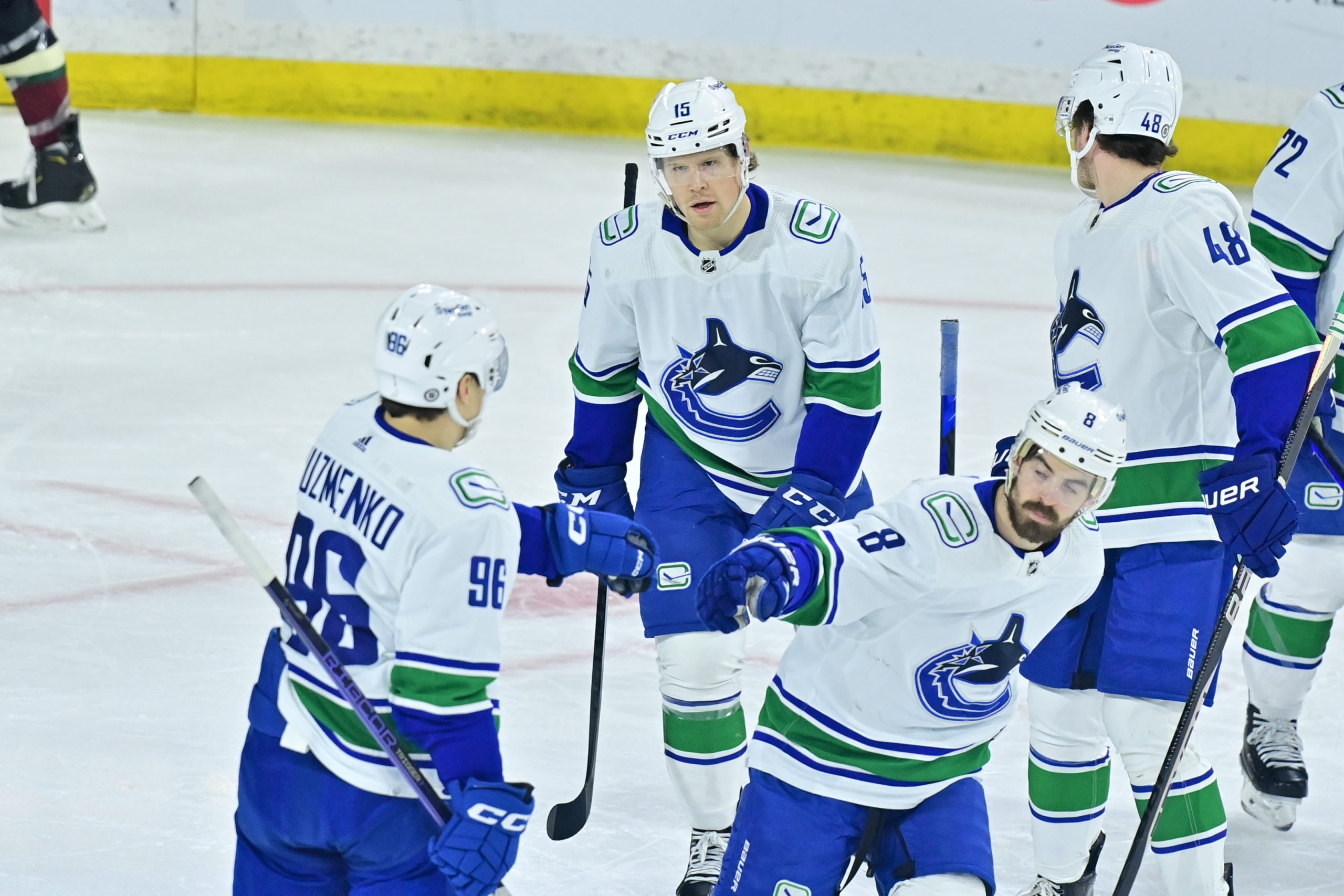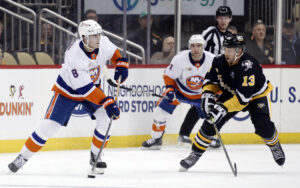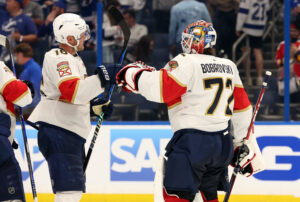It’s not a rebuild – but boy, the Vancouver Canucks could really use some help at the draft. If the Canucks drop down a few spots during the NHL draft in an effort to shed salary or gain picks, it will set the rest of their offseason in motion.
How the Canucks Can Drop In The NHL Draft
Dropping down in the NHL draft for the Canucks is only one tactic available to Vancouver, but it’s one worth looking at. It is the style of “sweetener” that would produce the least criticism at home. Canucks fans have little stomach for losing more high picks, but slipping a bit to get more? Much more tolerable.
So that establishes some ground rules for our speculation. The goal is to stay in the first round and gain something for the future in return. Only some teams can really manage that right now, though what happens between now and Draft Day will change that.
This still leaves Vancouver with options, assuming they can convince the other teams to come and play with them. Just don’t expect them to make any kind of deal until they see who is available at 11th overall.
Pittsburgh Penguins
Here is the first level of business for the Canucks during the NHL draft. You can always go home again! This is one of the teams in the running to get J.T. Miller before he signed in Vancouver. Heck, Miller’s name was talked about after he signed, as much because he was a local boy as filling a Penguins need. That’s not where we’re going with this.
Pittsburgh has few draft picks themselves after chasing the Stanley Cup with their Big Three. The trio of Sidney Crosby, Evgeni Malkin, and Kris Letang has won the city three championships and now they’re stuck. Are they pushing for more, or looking at the next generation?
One thing the Penguins need is cheaper skill – and that means younger players. But on the flip side is getting their veterans enough help to make a playoff run viable without selling off their future. If any team can be enticed by one of Vancouver’s available wingers, it’s the Penguins.
Should the Canucks drop down three spots, what can they get in return?
Making The Deal
You can generate one, but making one will be priority for the Canucks during the NHL draft. There are “draft slot values” charts out there, but frankly, those don’t mean a whole lot this early. Every draft is unique, and it’s still driven by individual players early on. Saying “first overall is 16% more valuable than second overall” is laughable when first overall is Connor Bedard.
So different players suit different teams. Pittsburgh’s* draft list is different than Vancouver’s, and their interest will ebb and flow accordingly. If, say, they MUST HAVE Axel Sandin-Pellika and don’t think he’ll make it to their spot, then a deal can be struck.
That all said, it’s not going to be a blockbuster. It is, after all, only three spots. But those three spots are the difference between a guarantee and possibly missing your pick completely.
To Pittsburgh
#11 draft spot
Conor Garland
To Vancouver
#14 draft spot
Mikael Granlund
The loss in this trade is twofold for Vancouver: the Canucks drop down three spots and get the worse player. They don’t get immediate help with the cap, but they do get out of the contract with Granlund a year earlier than they would with Garland.
It also moves salary from the wing to centre. While Granlund didn’t work for the Penguins, he can play a defensive role in Vancouver with lowered expectations. Yes, they’ll miss Garland, but scoring isn’t the Canucks biggest issue.
Nashville Predators
A double shot with Nashville, as they have two first-round picks. The first is only four spots back, so the same caveats with Pittsburgh hold here. The second, on the other hand, is a much farther leap of 13 places.
The Predators have some cap room, need scoring, and are hosting the draft. Vancouver did pretty well last time they traded with the draft’s home city, so why not again?
Deal the First
Nashville would probably like to keep their higher pick, especially in front of the home crowd. Still, moving up even a few spots adds drama!
To Nashville
#11 draft spot
Brock Boeser ($1.5 million retained)
To Vancouver
#15 draft spot
#83 draft spot
Callan Foote (RFA)
Foote hasn’t quite reached the solid NHL defenceman spot yet, but he has 141 NHL games under his belt. Vancouver needs a defenceman on the right side who can play defence, and that can be Foote. With only three seasons experience, he can be coached. Hopefully.
With Vancouver not even starting negotiations with right-side defenders Noah Juulsen and Kyle Burroughs, Foote is at worst a cheap replacement. If Ethan Bear does undergo surgery, they’ll need the numbers, too.
Nashville gets a proven scorer, though one who has fallen on hard times. Getting him at full price could have been possible, but shaving the salary makes the deal go down easier for the next two years. They can afford to flip the late third at that price.
Deal the Second
To Nashville
#11 draft spot
Conor Garland
To Vancouver
#24 draft spot
#46 draft spot
#47 draft spot
There’s making a splash for the home crowd, then there’s letting them know they can sleep in on day two. At first glance, this looks like a lot to give up – TWO second-round picks! – but moving to just outside the top ten has a lot of value.
The Predators take full freight of Garland’s contract, but he’s actually a good player, not just a salary dump. Nashville’s leading scorer was Roman Josi, their excellent defenceman who got 59 points in 2022-23. That’s not enough.
For Vancouver, well, there’s always the future. Now with more fingers crossed at hitting later instead of a more sure thing early. The Canucks drop down a lot, but they also drop substantial cap pressure. Gaining picks at the same time is as close to a win as they’ll get.
Chicago Blackhawks
Painful as it might be to deal with the team who stole the local star (or will, anyway), Chicago remains an option. If they want to give Connor Bedard some NHL players to play with, they’ll need to import them. The free agent market this year is just that bleak.
The problem with going into a full-throated tank is that there is nothing on the roster that interests any other team. Or, if not nothing then very little. What they can offer is draft value and cap space.
And before anyone mentions it, reaching the cap floor isn’t actually a problem. Overpay a couple UFAs and you’re there. But if moving up in the draft is something the Blackhawks want, then they’ll need to pay for it. And they can.
To Chicago
#11 draft spot
Tanner Pearson
Tucker Poolman
To Vancouver
#19 draft spot
#55 draft spot
Wait – so the Canucks drop down eight spots for a high second and what? Both Pearson and Poolman are LTIR candidates, not actual salaries! Their cap hits actually help Vancouver if they need to go over the limit! What the heck!
Okay, person who doesn’t exist but is convenient for the sake of this Socratic dialogue, I hear you. It’s a bit more complicated than that, so I’ll walk it through. The conditions are a bit complicated, but all that matters for this is the season’s opening.
Canucks Drop Down (to Abbotsford)
The long-term injured reserve is useful if, during the season, injuries force a team to call up players. But when a player is already injured – as Poolman and Pearson are – then to use that reserve they need to be on the roster at the start of the season. That’s $5.75 million worth of injured player.
Vancouver currently has two players on the NHL roster who don’t need to pass through waivers to be sent to the AHL. Those are Vasili Podkolzin and Nils Åman, totalling $1.8 million in salary – somewhat less than $5.75 million. Anyone else getting “papered down” can be lost.
The other unpleasant feature of using LTIR is that teams can’t accrue salary cap space while in it. That means any bonus money players reach needs to come off the next season’s cap. As of now, for instance, Vancouver is paying $850K against the cap hit for last year’s bonuses. Avoid LTIR, avoid a cap penalty in 2024-25.
This move doesn’t actually solve the Canucks’ cap issue, of course. But it does take pressure off hitting opening day with a cap-compliant roster and needing to give players away for nothing. And all it costs is a potential star player.
*Consider this repeated for all the teams listed here.
Main Photo: Matt Kartozian-USA TODAY Sports






